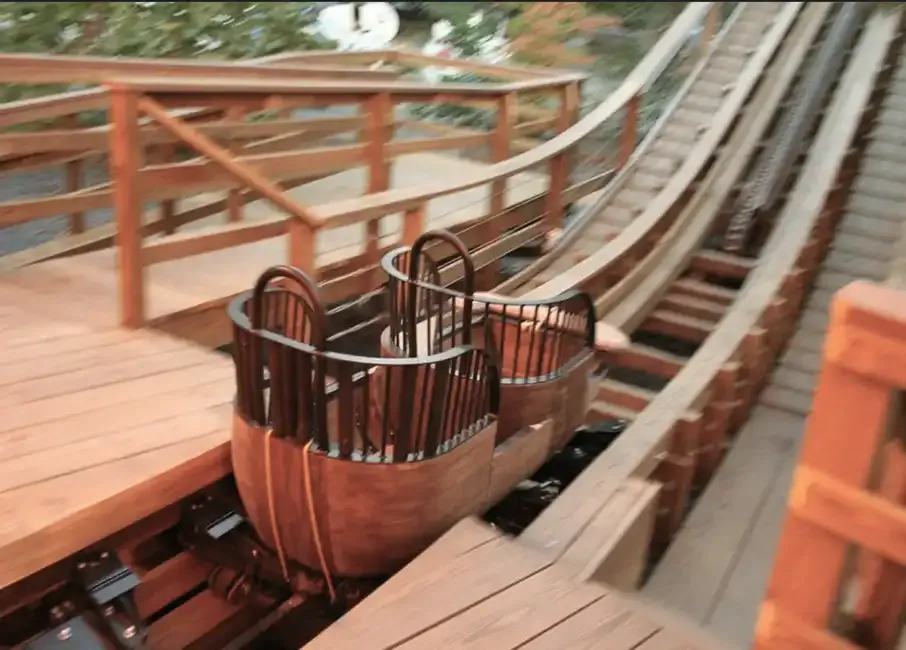
Nestled in the lush green hills of Elysburg, Pennsylvania, Knoebels Amusement Resort is known for its nostalgic appeal and classic wooden roller coasters. One ride, however, stands out for its unique design and historical significance: the Flying Turns. This one-of-a-kind roller coaster isn't just a throwback to the golden age of amusement parks; it’s a living, breathing piece of history brought back to life through modern ingenuity and dedication.
History of the Flying Turns
The original Flying Turns were invented in the 1920s and 1930s by John Norman Bartlett and John A. Miller. This type of coaster was inspired by the aerodynamic movements of bobsleds flying down the icy channels of the Olympic runs. Unlike traditional roller coasters with tracks, Flying Turns coasters used trough-like chutes made from wood or steel to simulate the sensation of riding a bobsled. Riders were sent careening through winding, banked curves in freely pivoting cars, creating a thrilling, unpredictable experience.
The first Flying Turns debuted at Euclid Beach Park in Cleveland, Ohio, in 1929, and its popularity spread quickly. Throughout the 1930s and early 1940s, various versions of the ride appeared in amusement parks across the United States and Europe. However, due to safety concerns and the increasing cost of maintenance, most of the original Flying Turns rides were dismantled by the 1960s. For decades, the concept seemed like a relic of the past — until Knoebels set out on a mission to revive it.
Knoebels’ Flying Turns: A Modern Rebirth
In 2005, Knoebels, known for its passion for preserving classic rides, announced plans to rebuild a Flying Turns coaster from scratch. It was a project driven by both nostalgia and a desire to bring something truly unique to their park. However, what initially seemed like a straightforward tribute quickly turned into a monumental engineering challenge. With no blueprints to follow and only a few vintage photographs and plans for guidance, the Knoebels team had to essentially reimagine the ride while ensuring it met modern safety standards.
The construction took much longer than expected — a full seven years, to be exact. This prolonged development period was due to various hurdles, including redesigning the cars, fine-tuning the wooden trough structure, and perfecting the overall ride dynamics. The park’s commitment to authenticity meant painstakingly crafting each element by hand, ensuring the new ride captured the spirit of the original.
Finally, in 2013, Knoebels unveiled its Flying Turns to the public, and it was worth the wait. With its open-air, bobsled-style cars and free-flowing movement, the ride quickly became a fan favorite, offering a completely different experience from other roller coasters.
Ride Experience
Knoebels’ Flying Turns starts with a slow chain lift that cranks riders to the top of the hill. As the cars enter the first descent, riders are immediately thrown into a fast-paced, twisting journey through a narrow wooden trough. The sensation of gliding and banking through the curves is accentuated by the feeling of the cars being "loose" in the chute, allowing them to gently rock and sway. Each ride is unique due to the subtle variations in car speed and path.
With a maximum height of 50 feet and a top speed of around 25 mph, the Flying Turns may not be the most extreme coaster in the park, but it offers a one-of-a-kind, exhilarating experience that blends nostalgia and thrill perfectly. The ride lasts just over a minute but delivers a sensation of freedom that’s hard to match.
Construction and Technical Details
Knoebels’ Flying Turns consists of three trains, each with three cars capable of seating two passengers. The design of these trains was one of the biggest challenges faced during development, as they needed to navigate the tight, serpentine course without getting caught in the curves or tipping over. Each car is constructed with a pivoting mechanism, allowing them to smoothly handle the ride’s sharp turns.
The entire structure is made from treated wood, with steel reinforcements at key points to enhance durability. The trough itself is meticulously shaped to allow for a perfect balance of speed and stability, ensuring that each train remains safely centered while still providing the sensation of being “unbound” by the track.
Why Knoebels’ Flying Turns is a Must-Ride
The Flying Turns at Knoebels is more than just a roller coaster; it’s a historical revival and a testament to Knoebels’ commitment to preserving the essence of classic amusement rides. For fans of vintage coasters, it offers the chance to experience a ride that hasn’t existed elsewhere for decades. For thrill-seekers, it provides a completely different type of adventure — one where unpredictability and motion take precedence over sheer speed and height.
Moreover, the Flying Turns is a symbol of Knoebels’ dedication to innovation and craftsmanship. The fact that this ride exists today is thanks to years of effort, passion, and attention to detail, making it a living piece of roller coaster history.
The Flying Turns at Knoebels is a marvel of engineering and a rare gem in the world of amusement parks. With its vintage charm, unique ride dynamics, and engaging backstory, it stands as a beloved attraction for both coaster enthusiasts and casual park-goers alike. Whether you're a thrill-seeker or a history buff, a ride on the Flying Turns is a journey into the past — and an adventure worth experiencing again and again.
The Flying Turns at Knoebels is a marvel of engineering and a rare gem in the world of amusement parks. With its vintage charm, unique ride dynamics, and engaging backstory, it stands as a beloved attraction
